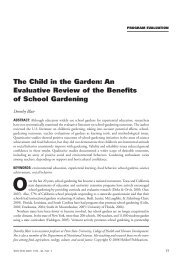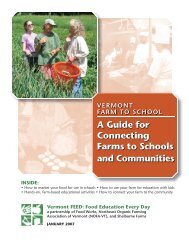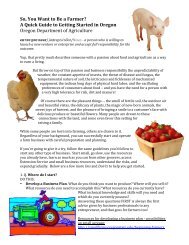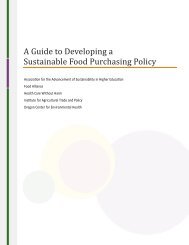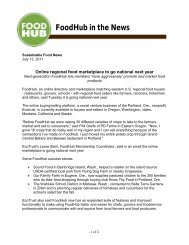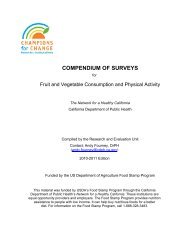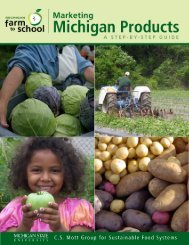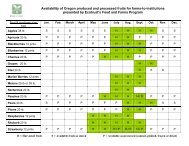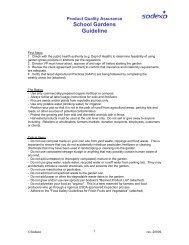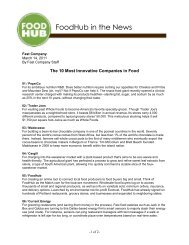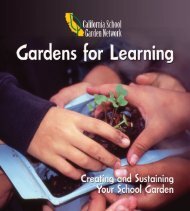eval report cover.indd - New Jersey Farm to School Network Wiki
eval report cover.indd - New Jersey Farm to School Network Wiki
eval report cover.indd - New Jersey Farm to School Network Wiki
Create successful ePaper yourself
Turn your PDF publications into a flip-book with our unique Google optimized e-Paper software.
Introduction <strong>to</strong> <strong>Farm</strong> <strong>to</strong> <strong>School</strong> EvaluationIt is important <strong>to</strong> <strong>eval</strong>uate both the processes and impacts of farm <strong>to</strong> school programs.Process <strong>eval</strong>uation indica<strong>to</strong>rs may be moni<strong>to</strong>red <strong>to</strong> meet the project deliverables anddescribe implementation of a project. These typically include, but are not limited <strong>to</strong>,the number of operational programs, schools participating, children participating,farmers supplying food, school gardens developed, trainings and educational sessionsconducted, recipes developed, curriculum or lessons implemented, etc. Impact <strong>eval</strong>uationindica<strong>to</strong>rs are aimed at examining outcomes related <strong>to</strong> program implementation,and usually require more expertise and financial resources <strong>to</strong> gather and analyze. <strong>Farm</strong><strong>to</strong> school impact <strong>eval</strong>uation can be conducted through a variety of qualitative methods(interviews, focus groups, surveys with open ended questions), and quantitativemethods (changes in weight, body mass index, academic scores, and in local productpurchased).Another consideration for <strong>eval</strong>uation planning is ethics, which includes the use of humansubjects in <strong>eval</strong>uation. Federal regulations govern the protection of research participants,especially children. An entity known as the Institutional Review Board (IRB),based at universities and other research organizations, is charged with reviewing andapproving any research that involves the participation of people. It is important <strong>to</strong> beaware of and follow these regulations, especially if a farm <strong>to</strong> school program is fundedwith public monies. See www.hhs.gov/ohrp/ for more information.Deciding on the scope and focus area for a farm <strong>to</strong> school program <strong>eval</strong>uation dependson resources available – financial, staff expertise, and skills. Hiring or developing a contractualrelationship with an experienced professional <strong>eval</strong>ua<strong>to</strong>r is an option, though itmay pose a challenge for programs with limited financial resources. Researchers fromlocal universities and colleges may be interested in developing connections with farm <strong>to</strong>school programs and could serve as valuable partners for <strong>eval</strong>uation.For farm <strong>to</strong> school programs, information generated through research and <strong>eval</strong>uationmay be broadly classified in<strong>to</strong> the following categories, with some examples providedbelow:Baseline / Existing Program Information / Feasibility StudiesBaseline information on pre-program indica<strong>to</strong>rs, existing information on number offarm <strong>to</strong> school programs already in operation, key components and features. Th is mayalso include a feasibility analysis using findings from the baseline data collection.Student ImpactsChanges in knowledge, attitudes, behaviors regarding food choices and nutrition, health,local foods, agriculture, environment; changes in Body Mass Index (BMI), academicperformance, discipline, attendance, and activity patterns.10 Bearing Fruit: <strong>Farm</strong> <strong>to</strong> <strong>School</strong> Evaluation Resources and Recommendations



